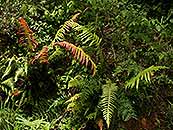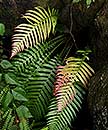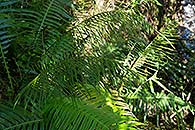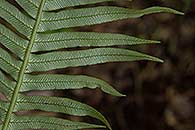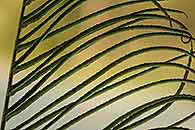Blechnum attenuatum (Sw.) Mett.
Synonyms |
Blechnum attenuatum (Sw.) Mett. var. giganteum (Kaulf.) Bonap. |
|---|---|
Common name |
Pink-leaved blechnum |
Description |
Rhizome creeping to suberect, up to 4 cm thick and up to 50 cm long; rhizome scales pale to dark brown, 1.2-2 x 0.1-0.3 cm, linear-lanceolate in outline, apex gradually tapering to a point, margins entire. Fronds dimorphic, tufted, thinly to firmly leathery. Stipe up to 12 (-28)cm, pale brown and glabrous except for scales similar to the rhizome clustered at the base. Sterile lamina 23-180 × 4.5-36 cm, narrowly elliptic to lanceolate in outline, pinnate, pinnae gradually reducing downwards with lowermost pinnae rudimentary; pinnae 3-18 x 1-1.8 cm triangular-oblong to linear in outline, apex gradually tapering to a point, base broadly attached to the rhachis, margin entire. Fertile fronds similar in size or longer than sterile fronds, pinnae thin, linear in outline, 4-14 x 0.3-0.4 cm, base widened and joined to the rhachis. Sori linear, covering the whole length of the fertile pinnae; indusium linear, 1 mm wide, entire to slightly erose. |
Notes | B. attenuatum resembles B. inflexum and B. punctulatum. In B. attenuatum the fertile fronds are of similar size as the sterile fronds, sterile pinnae are not overlapping towards the lamina apex, base of the pinnae is adnate to the rhachis. |
Derivation | attenuatum: tapering, pinnae taper to a sharp point. |
Habitat | Streambanks in open montane grassland or shaded areas in evergreen forest. |
Distribution worldwide | Africa, Madagascar, the Comoro Islands, Réunion, Mauritius. |
Distribution in Africa |
Burundi, Cameroon, Ethiopia, Kenya, Malawi, Mozambique, Rwanda, South Africa, Swaziland, Tanzania , Zambia, Zimbabwe. |
Growth form |
Epiphytic, lithophytic, terrestrial. |
Literature |
|
